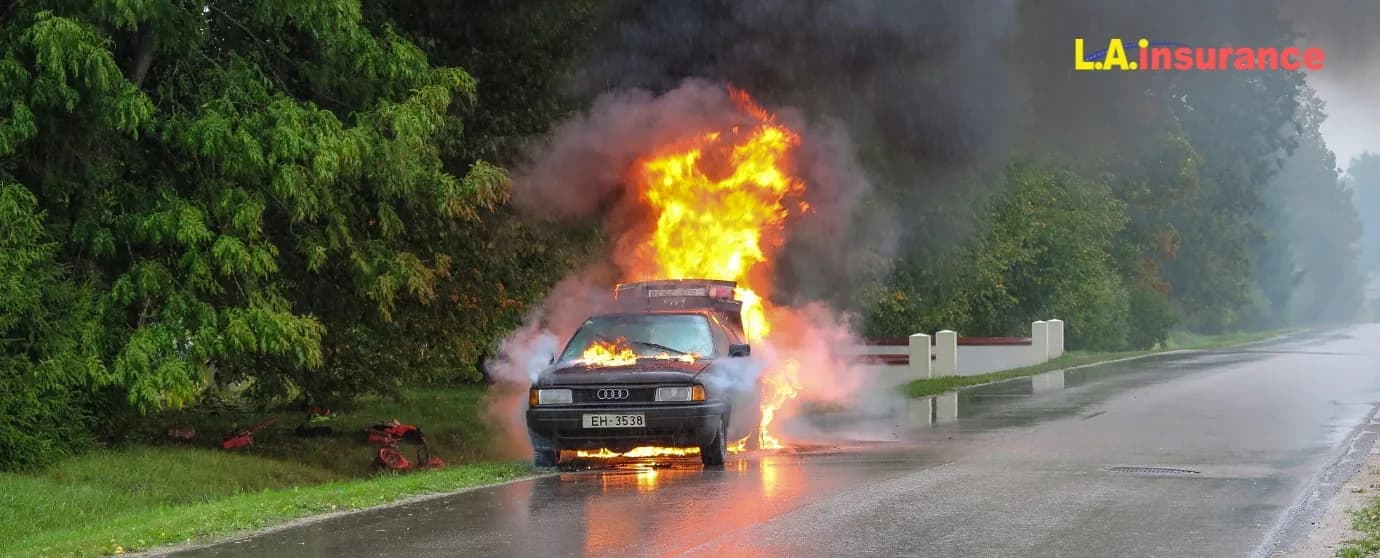
Publish Date: 16-11-2024
Auto Insurance
Last Updated: 18-11-2024
Is Colorado a No-Fault State for Auto Insurance?
Have you ever found yourself wondering how car accident insurance works in Colorado? If you recently got a new driver's license or bought your first car that you intend to insure in Colorado, you might scratch your head asking yourself, “Is Colorado a no-fault state for auto insurance?”
Well, Colorado is not a no-fault state. The state operates under fault-based rules which means the driver responsible for the accident is liable for the damages. However, it might feel tough for you to understand the ins and outs of car insurance laws in Colorado. So, let us help you know some of the basics of auto insurance laws in Colorado that are related to your inquiry.
What Is a No-Fault State?
In no-fault states, your own insurance covers your damages regardless of who caused the accident. This usually means faster claims processing since there’s no need to establish fault. However, it also often limits your ability to sue the other driver for damages unless certain conditions are met. However, a no-fault-based system has been introduced in 12 states so far. It aims to reduce litigation as well as speed up and simplify claims processing.
According to the Insurance Information Institute (III), the no-fault system is intended to lower the cost of auto insurance by taking small claims out of the courts. Typically, no-fault insurance (AKA Personal Injury Protection or PIP) provides several advantages, including:
- Faster claims processing
- Reduced legal costs
However, it also has its downsides:
- Limited ability to seek full compensation from the at-fault driver.
- Potential restriction on claiming non-economic damages such as pain and suffering.
Is Colorado a No-Fault State for Auto Insurance?
Colorado is not a no-fault state for auto insurance. It operates under a traditional fault-based system which is also known as a “tort” system. If you’re living in Colorado and responsible for causing the accident, you’re liable for paying the damages.
That’s why you need to carry minimum liability insurance if you intend to drive across Colorado state. This way, if you cause a car crash in the state, you or your insurance company is responsible for the costs incurred by the other party, including property damage and bodily injuries.
The transition from No-Fault to Fault in 2003
Colorado wasn’t always a fault-based state. It has seen significant changes. Before 2003, the state operated under a no-fault insurance system. During this period, drivers would claim damages from their own insurance, irrespective of who caused the accident. This system was intended to speed up claims and reduce the number of lawsuits.
Now, in the event of an accident, the driver found at fault is responsible for covering the damages. This transition has had a profound impact on how claims are processed and who bears the financial burden following an accident.
In short, the switch from no-fault to fault-based insurance in Colorado was driven by several factors:
- Reducing overall insurance costs.
- Minimizing the number of frivolous lawsuits.
- And to make sure that the responsible party is held accountable.
Read More: Does Car Insurance Cover Car Battery?
Minimum Auto Insurance Requirements Colorado
Colorado law mandates that all drivers carry a minimum amount of auto insurance. According to the Colorado General Assembly, the minimum coverage requirements include:
- $25,000 for bodily injury or death per person.
- $50,000 for bodily injury or death per accident.
- $15,000 for property damage per accident.
This minimum coverage makes sure that you’re financially protected in the event of an accident. However, it would be wise to consider additional coverage options like underinsured/uninsured motorist protection, which can be invaluable if you’re involved in an accident with a driver who lacks sufficient insurance.
Why Should You Carry a Minimum Liability Insurance in Colorado
First of all, it’s a legal obligation. Liability insurance isn’t only mandated by the State law of Colorado but it also applies to any state that operates under a fault-based system. It covers the costs of bodily injury and property damage if you’re at fault in an accident. Plus, you’ll always be protected from significant financial loss and legal repercussions.
If you manage a fleet of vehicles or have valuable assets, having higher insurance limits or an umbrella policy can help you feel safer. If you run a car-related business with over 25 vehicles that need commercial auto insurance, this coverage can give you better protection, help you comply with legal requirements, and safeguard your assets.
Filing a Claim in a Fault State
If you’re involved in an accident in Colorado, finding out who is at fault is the first step. Once fault is established, you file a claim with the at-fault driver’s insurance. This process can be complex. In some situations, you may need an experienced lawyer to help you with your claim and to deal with insurance companies.
However, you can avoid all these unnecessary hassles with the country’s cheapest insurance agency. Yes, at L.A. Insurance, we offer you the most affordable full-coverage auto insurance policies in Colorado. Whether you live in Denver, Colorado Springs, Aurora, or Arvada, you can easily reach out to our cheap insurance agents in Colorado. You can find an agent online and get your car insurance quote at the quickest possible time.
Understanding Comparative Negligence
Colorado follows a modified comparative negligence law. This means if you’re partially at fault for an accident, your compensation is reduced by your percentage of fault. For instance:
- If you’ve found 30% at fault, you can only recover 70% of your damages.
- If you’re more than 50% at fault, you cannot recover any damages from the other party.
What Happens When the At-Fault Driver’s Insurance Isn’t Enough?
There are instances when the at-fault driver’s insurance may not be sufficient to cover all your damages. In such cases, you can file a personal injury lawsuit to recover the remaining amount. Getting legal help is important because dealing with these claims can be difficult without expert support.
Role of Uninsured/Underinsured Motorist Coverage
Uninsured/Underinsured Motorist coverage can be a lifesaver in these situations. This additional coverage protects you if you’re involved in an accident with a driver who lacks sufficient insurance. It ensures that your medical expenses and other damages are covered, even if the at-fault driver's insurance falls short. Considering this coverage can provide significant financial protection and a sense of peace!
Non-Economic Damages and Caps
Non-economic damages include compensation for pain and suffering, emotional distress, and loss of enjoyment of life. These damages are meant to address the more intangible consequences of an accident that don’t have a clear monetary value.
Colorado’s Damage Caps
Colorado has caps on non-economic damages to ensure fair compensation while preventing excessive awards. As of January 1, 2025, the cap on non-economic damages is set at $1.5 million for personal injury cases. Prior to this date, the cap was 250,000. This significant increase aims to provide fairer compensation for those with severe injuries. The Colorado Revised Statutes detail these caps and their application.
Tips for Avoiding Car Accidents and Ensuring Sufficient Coverage
The best way to protect yourself from financial loss in the event of an accident is to carry sufficient liability insurance and additional coverage options like uninsured/underinsured motorists protection. Practicing nighttime safe driving habits, like being sober, avoiding distractions, and adhering to speed limits, is also equally important. Colorado law requires drivers to carry proof of insurance at all times. So, if you fail to provide proof of insurance during a traffic stop, it can result in hefty fines and other penalties.
For general education and awareness, we should also do the following:
- Public awareness campaigns are needed to educate the public about auto insurance laws and the dangers of reckless driving.
- More targeted campaigns focusing on young adults and repeat offenders could yield better outcomes.
- Let residents know that Colorado car insurance can be expensive, especially if they are involved in a fender bender.
- Encouraging the use of technology such as ignition interlock devices can prevent repeat offenses by ensuring that drivers cannot operate their vehicles under the influence.
Is Colorado a no-fault auto insurance state: The Bottom Line
Colorado is not a no-fault auto insurance state. Instead, it follows a fault-based system, meaning the driver responsible for the accident must cover the costs of damage and injuries. In Colorado, the at-fault driver’s insurance pays for medical bills, property damage, and other losses. Because of this, drivers must carry adequate liability insurance.
Learn More: Do You Need Insurance to Register a Car in Colorado?
Frequently Asked Questions Related to Colorado’s No-Fault Car Insurance (FAQs)
Does Colorado Have No-Fault Car Insurance?
No, Colorado is a fault state or “tort” state which means the at-fault driver is responsible for the damages.
How is Fault Determined in a Car Accident in Colorado?
In Colorado, fault in a car accident is determined by negligence. This involves proving that a driver failed to exercise reasonable care which leads to the accident. Factors such as police reports, witness statements, and evidence of traffic violations are considered. In Colorado, if more than one driver is at fault in an accident, each driver must pay for their share of the damages based on how much fault they have.
When Did Colorado Become an At-Fault State?
Colorado transitioned to an at-fault state in 2003. This change shifted the responsibility for covering damages to the driver who caused the accident, intending to reduce car insurance costs and a number of litigations.
Can I Get More Than the Minimum Required Insurance in Colorado?
Yes, you can purchase additional coverage to protect against various risks and make sure you’re fully covered. In addition to the state’s mandatory liability coverage, drivers often start adding options like collision, comprehensive, uninsured and underinsured motorist, and personal injury protection (PIP) for greater financial protection. This additional coverage usually covers vehicle damage, medical bills, and losses beyond the state’s basic requirements.
What Should I Do Immediately After a Car Accident in Colorado?
- Prioritize your safety.
- Call 911.
- Document the scene with photos.
- Contact an attorney to help with your claim.
Are Non-Economic Damages Capped in Colorado?
Yes, non-economic damages are capped at $1.5 million for cases filed on or after January 1, 2025. Prior to this, the cap was $250,000.
Tag :
Auto insurance
best auto insurance
Comercial Auto








